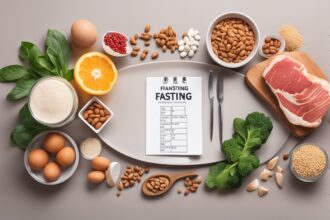Fasting has become a popular health and wellness practice, with many individuals adopting it for weight loss, improved metabolic health, and even mental clarity. However, one question often arises among those who fast and prioritize fitness or muscle maintenance: how can you ensure you’re getting enough protein without breaking your fast? This is where the concept of optimal protein timing during fasting comes into play. By strategically planning when and how to consume protein, you can maximize the benefits of fasting while supporting muscle recovery and overall health. In this post, we’ll explore the science behind protein timing, how it aligns with fasting, and actionable strategies to make it work for you.
What Is Optimal Protein Timing During Fasting?
Optimal protein timing during fasting refers to the strategic consumption of protein around fasting periods to support muscle synthesis, recovery, and overall health without disrupting the metabolic benefits of fasting. Fasting, whether intermittent (such as the 16:8 method) or prolonged (24+ hours), puts the body in a state of reduced nutrient intake, which can trigger autophagy (cellular repair) and fat burning. However, this state can also lead to muscle protein breakdown if not managed properly. Timing protein intake during feeding windows or immediately after breaking a fast is crucial to counteract this effect.
The goal is to balance the anabolic (muscle-building) effects of protein with the catabolic (breakdown) state induced by fasting. Research suggests that consuming protein in specific windows can enhance muscle protein synthesis while preserving the benefits of fasting, such as improved insulin sensitivity and fat loss.
Why Protein Timing Matters During Fasting
Protein is essential for repairing and building muscle tissue, especially for those who engage in resistance training or other forms of exercise during fasting. When you fast, your body may turn to stored protein (muscle tissue) for energy, particularly if glycogen stores are depleted. This process, known as gluconeogenesis, can lead to muscle loss over time if protein intake isn’t adequately timed or sufficient.
By focusing on optimal protein timing during fasting, you can minimize muscle breakdown and maximize muscle protein synthesis (MPS). Studies have shown that consuming protein post-exercise or immediately after breaking a fast can stimulate MPS more effectively than spreading intake randomly throughout the day. Additionally, timing protein intake can help manage hunger hormones like ghrelin, making fasting more sustainable. For more insights on managing hunger during fasting, check out our post on Fasting and Hunger Management.
How Fasting Affects Protein Needs
Fasting alters the body’s metabolic state, which can influence how much protein you need and when you should consume it. During a fast, insulin levels drop, and the body relies on stored energy (fat and glycogen) for fuel. While this is beneficial for fat loss, it can also increase the risk of muscle catabolism, especially during extended fasts or intense exercise.
Research indicates that individuals who fast may need slightly higher protein intake during feeding windows to preserve lean mass. A general guideline is to aim for 0.7–1.0 grams of protein per pound of body weight daily, depending on activity level. Timing this intake—particularly post-fast or post-workout—can enhance recovery and prevent muscle loss. If you’re curious about protein sources that align with fasting, explore our guide on Best Protein Sources for Fasting.
Best Times to Consume Protein During Fasting
Determining the best time to consume protein during fasting depends on your fasting protocol and lifestyle. Here are some key windows to consider for optimal protein timing:
- Post-Fast (Breaking the Fast): Consuming protein immediately after ending a fast is one of the most effective ways to stimulate muscle protein synthesis. A meal or shake with 20–40 grams of high-quality protein (like whey or lean meats) can kickstart recovery.
- Post-Workout: If you exercise during a fasted state, prioritize protein intake within 30–60 minutes after your workout. This helps repair muscle damage and replenish amino acid stores. Pairing protein with a small amount of carbs can further enhance recovery.
- Evening Feeding Window: For those following intermittent fasting (e.g., 16:8), consuming protein in the evening can support overnight muscle repair. Slow-digesting proteins like casein are ideal for sustained amino acid release.
Experiment with these windows to find what works best for your schedule and goals. For additional tips on structuring meals around fasting, see our article on Meal Planning for Intermittent Fasting.
Potential Challenges and How to Overcome Them
While optimal protein timing during fasting offers numerous benefits, it’s not without challenges. One common issue is overeating during feeding windows, which can negate the calorie deficit created by fasting. To avoid this, focus on high-protein, nutrient-dense foods that promote satiety, such as eggs, fish, and legumes.
Another challenge is maintaining energy levels for workouts during a fasted state. If you feel sluggish, consider scheduling exercise closer to your feeding window or incorporating branched-chain amino acids (BCAAs) if your fasting protocol allows. However, note that BCAAs may break a strict fast for some individuals. Learn more about fasting and exercise in our post on Fasting and Exercise: What You Need to Know.
Lastly, digestive discomfort can occur if you consume large amounts of protein immediately after a fast. Start with smaller, easily digestible portions and gradually increase as your body adjusts.
Practical Tips for Implementing Protein Timing with Fasting
Successfully integrating protein timing into your fasting routine requires planning and consistency. Here are some practical tips to help you achieve optimal protein timing during fasting:
- Plan Your Meals: Prepare protein-rich meals or shakes in advance to ensure you hit your intake goals during feeding windows.
- Use Supplements Wisely: Whey protein or plant-based protein powders can be a convenient way to meet protein needs without excessive calories.
- Track Your Intake: Use a nutrition app to monitor protein consumption and ensure you’re meeting your daily targets.
- Stay Hydrated: Proper hydration supports digestion and recovery, especially when consuming protein after a fast.
For a deeper dive into supplements that complement fasting, check out our guide on Supplements for Fasting Support.
Disclaimer: The information provided in this post is for educational purposes only and should not be considered medical advice. Fasting and dietary changes, including protein timing, may not be suitable for everyone, especially those with underlying health conditions, pregnant or breastfeeding individuals, or those on specific medications. Always consult with a healthcare professional or registered dietitian before making significant changes to your diet or fasting routine.
References
- Tipton, K. D., & Wolfe, R. R. (2019). Protein and amino acids for athletes. Journal of Sports Sciences.
- Harvard Health Publishing. (2018). Intermittent Fasting: Surprising Update.
- Schoenfeld, B. J., Aragon, A. A., & Krieger, J. W. (2013). The effect of protein timing on muscle strength and hypertrophy: a meta-analysis. Journal of the International Society of Sports Nutrition.
- Mayo Clinic. (2021). Protein: How much do you need?
- Morton, R. W., et al. (2018). A systematic review, meta-analysis and meta-regression of the effect of protein supplementation on resistance training-induced gains in muscle mass and strength. British Journal of Sports Medicine.
This content is for informational purposes only and not a substitute for professional advice.






